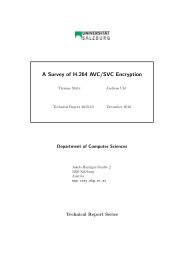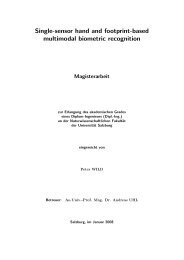Pit Pattern Classification in Colonoscopy using Wavelets - WaveLab
Pit Pattern Classification in Colonoscopy using Wavelets - WaveLab
Pit Pattern Classification in Colonoscopy using Wavelets - WaveLab
You also want an ePaper? Increase the reach of your titles
YUMPU automatically turns print PDFs into web optimized ePapers that Google loves.
5 Results<br />
5.2.2 Best-basis method based on structural features (BBS)<br />
As we saw <strong>in</strong> section 4.3.3.3 this method is similar to the method <strong>in</strong> the previous section. But<br />
for the tests with this method we used the structural feature extractors FEUNV (based on the<br />
unique node values) and FETS (based on the complete tree structure) already presented <strong>in</strong><br />
section 4.3.3.3. Apart from that we used KNNTD (distances based on trees and a quadtree<br />
distance metric <strong>in</strong>stead of feature vectors and a vector distance metric) <strong>in</strong> conjunction with<br />
the k-NN classifier.<br />
Just like <strong>in</strong> the previous method, the best results have been obta<strong>in</strong>ed us<strong>in</strong>g the gray scale<br />
versions of the pit pattern images.<br />
As we can see <strong>in</strong> table 5.3, <strong>in</strong> the two classes case the best result obta<strong>in</strong>ed for the pit<br />
pattern images was 78% us<strong>in</strong>g the SVM classifier. The best result achieved with the k-NN<br />
classifier was clearly lower with a percentage of correctly classified images of 58%.<br />
In the six classes case aga<strong>in</strong> the SVM classifier clearly outperforms the k-NN classifier<br />
with a classification result of 56% compared to 35% and the misclassification rates for pit<br />
pattern types III-S and V aga<strong>in</strong> are extremely high, just like <strong>in</strong> the previous method.<br />
Additionally we can see <strong>in</strong> table 5.3 that the classification performance seems to be superior<br />
for the second class <strong>in</strong> the two classes case for the k-NN classifier. In the six classes<br />
case the results are similar - while pit pattern type I gets classified clearly worse than type<br />
IV, the classification fails completely for all other types.<br />
Compared to the tests with the pit pattern images, the tests performed us<strong>in</strong>g the Outex<br />
images resulted <strong>in</strong> very high classification results, as can been seen <strong>in</strong> the tables 5.4 and<br />
5.5. In the two classes case the total classification result was 97% for the k-NN classifier<br />
and 89% for the SVM classifier. In the six classes case the classification result was 53% for<br />
the k-NN classifier. The top result achieved with the SVM classifier is a bit lower with an<br />
overall classification result of 45%.<br />
At this po<strong>in</strong>t it is worthwhile to mention that dur<strong>in</strong>g the first test runs the SVM results<br />
for the Outex images were conspicuously worse with a top result of 0%. After limit<strong>in</strong>g the<br />
number of SVM tra<strong>in</strong><strong>in</strong>g samples however, we were able to get clearly higher results. To<br />
achieve these results we tra<strong>in</strong>ed the SVM classsifier with only 10% out of all images.<br />
From table 5.6 we see, that regard<strong>in</strong>g the pit pattern images <strong>in</strong> conjunction with the k-NN<br />
classifier the structural feature extractor KNNTD always delivered the best results. While<br />
<strong>in</strong> the two classes case the best result has been achieved with a value for k of 50, the best<br />
results <strong>in</strong> the six classes case has been obta<strong>in</strong>ed us<strong>in</strong>g a smaller k-value of 43. When us<strong>in</strong>g<br />
the SVM classifier however, the best results have been achieved us<strong>in</strong>g the FEUNV feature<br />
extractor.<br />
For the Outex images <strong>in</strong> connection with the k-NN classifier the values for k lead<strong>in</strong>g to<br />
the best overall classification results are clearly much lower than for the pit pattern images<br />
72








